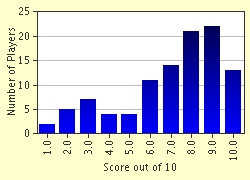Quiz Answer Key and Fun Facts
1. Until World War I, Australia had a strong and innovative film industry, which was finally overtaken by the dominance of American films in the 1920s. "The Story of the Kelly Gang" was produced in 1906, and marked the beginning of Australia's love affair with the movies. What was so unusual about this film?
2. In 1955 Australia's first colour feature film was released. Following the life of a young Aboriginal girl growing up in a closed white community, it featured a cast of non-professional Aboriginal actors. This movie was the first Australian film to be shown at the Cannes Film Festival. What was its name?
3. Despite a promising start, the Australian film industry languished in the late 1950s and early 1960s. Most of the major films produced were American ventures, with American casts and only a few Australians in supporting roles. Set in an Australia facing destruction in the shadow of an advancing radiation cloud, which powerful 1959 film traced the lives of nuclear holocaust survivors?
4. The dearth of quality Australian films was finally addressed in the early 1970s, when the Australian government introduced a raft of funding opportunities. One film which benefited from this financial support received international acclaim. Set in a country girls' school on St. Valentine's Day, which haunting film told the story of the disappearance of some of young pupils on a fateful school outing?
5. The most successful Australian film of the early 1970s told the story of a man who worked in a waterbed store. He was an ordinary young fellow, who spent the entire film being inexplicably pursued by flocks of attractive girls. Which film recorded his amazing love exploits?
6. A low budget film released in 1979 left a lasting impression on movie goers around the world. Set in a decaying, futuristic Australia and starring Mel Gibson, which movie told the story of a cop who sought revenge when his family was killed by a biker gang?
7. In 1986 an Australian film hit movie theatres around the world and redefined the quintessential Australian character. With a twinkling smile and a rather large knife, Mick "Crocodile" Dundee conquered the streets of New York City with the same flair he used when wrestling crocodiles or hypnotising buffalo in the Australian Outback. Also credited with writing the extremely funny script, who starred in the title role?
8. The 1990s saw steady growth in the Australian film industry. Apart from increased funding, the Australian government also offered attractive tax concessions to film investors. Film makers became more innovative and broached subject matter that had previously been regarded as unsuitable or even offensive. Which movie flew in the face of Australian convention and tackled controversial subject matter?
9. In 1998 Fox Studios opened in Sydney. This marked the emergence of a new confidence in the country's film industry and provided an attractive alternative for overseas movie makers. One of the first movies produced at Fox had its own purpose built set, and facilities were provided for some of its stars to live entirely within the studio complex during filming. Which film featured a young hero who set out to save the place he called home?
10. In 2002, director Phillip Noyce dared to tackle a shameful subject that has long haunted Australia. Based on a true story, the film followed three young Aboriginal girls as they tried to find their families and reclaim their heritage. What is the name of this powerful movie?
Source: Author
Nannanut
This quiz was reviewed by FunTrivia editor
skunkee before going online.
Any errors found in FunTrivia content are routinely corrected through our feedback system.

